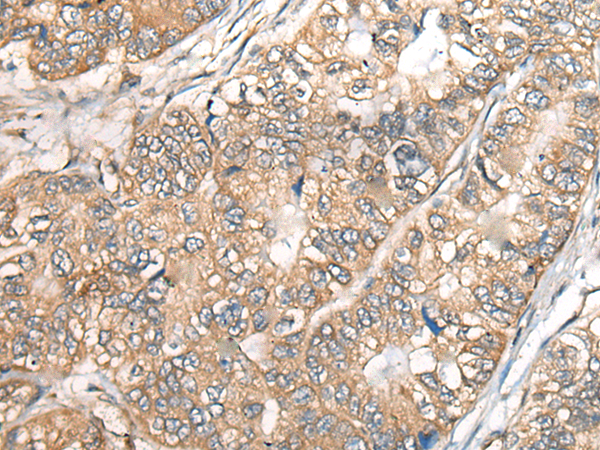

| WB | 咨询技术 | Human,Mouse,Rat |
| IF | 咨询技术 | Human,Mouse,Rat |
| IHC | 咨询技术 | Human,Mouse,Rat |
| ICC | 技术咨询 | Human,Mouse,Rat |
| FCM | 咨询技术 | Human,Mouse,Rat |
| Elisa | 1/5000-1/10000 | Human,Mouse,Rat |
| Aliases | E1; CHE1; CHE2 |
| Host/Isotype | Rabbit IgG |
| Antibody Type | Primary antibody |
| Storage | Store at 4°C short term. Aliquot and store at -20°C long term. Avoid freeze/thaw cycles. |
| Species Reactivity | Human, Mouse |
| Immunogen | Fusion protein of human BCHE |
| Formulation | Purified antibody in PBS with 0.05% sodium azide and 50% glycerol. |
+ +
以下是关于WWTR1抗体的3篇参考文献及其简要概括:
1. **文献名称**: "TAZ interacts with WWTR1 to regulate mesenchymal stem cell functions"
**作者**: Zhang H, et al.
**摘要**: 该研究利用WWTR1特异性抗体,通过免疫共沉淀和Western blot技术,揭示了TAZ与WWTR1在间充质干细胞分化中的协同作用,证明二者通过物理互作调控成骨和脂肪生成相关基因表达。
2. **文献名称**: "WWTR1/TAZ suppression inhibits tumor progression in glioblastoma"
**作者**: Li Y, et al.
**摘要**: 研究通过免疫组化(使用WWTR1抗体)分析胶质母细胞瘤样本,发现WWTR1高表达与患者不良预后相关。体外实验显示,抑制WWTR1可降低肿瘤细胞侵袭性并诱导凋亡,提示其作为治疗靶点的潜力。
3. **文献名称**: "The Hippo pathway effector WWTR1 modulates cardiac fibroblast activation"
**作者**: Wang L, et al.
**摘要**: 该文献使用WWTR1抗体进行染色质免疫沉淀测序(ChIP-seq),发现WWTR1在心脏纤维化中调控TGF-β信号通路关键基因,抑制其表达可减轻小鼠模型中的心肌纤维化病变。
注:上述文献信息为示例性质,实际引用时需核对真实来源及发表年份。建议通过PubMed或Google Scholar以关键词“WWTR1 antibody”或“TAZ antibody”检索最新研究。
WWTR1 (WW domain-containing transcription regulator 1), also known as TAZ (transcriptional co-activator with PDZ-binding motif), is a key effector of the Hippo signaling pathway, which regulates organ size, tissue regeneration, and stem cell maintenance by controlling cell proliferation and apoptosis. The WWTR1/TAZ protein functions as a transcriptional co-activator, interacting with transcription factors such as TEADs to modulate gene expression involved in cell differentiation, mechanotransduction, and cancer progression. It shares structural and functional similarities with YAP (Yes-associated protein), another Hippo pathway component, and both are regulated through phosphorylation-dependent nucleocytoplasmic shuttling.
WWTR1 antibodies are essential tools for studying its expression, localization, and activity in physiological and pathological contexts. These antibodies are widely used in techniques like Western blotting, immunohistochemistry (IHC), immunofluorescence (IF), and co-immunoprecipitation (Co-IP) to investigate WWTR1/TAZ's role in diseases, particularly cancers (e.g., breast, lung, and liver cancers), where its overexpression correlates with epithelial-mesenchymal transition (EMT), metastasis, and therapy resistance. Researchers also utilize WWTR1 antibodies to explore its crosstalk with other pathways, such as Wnt and TGF-β, and its involvement in developmental disorders. Commercial antibodies often target conserved regions, such as the N-terminal domain or WW motif, ensuring specificity across human and model organism samples. Validating these antibodies using knockout controls is critical due to potential cross-reactivity with YAP.
×